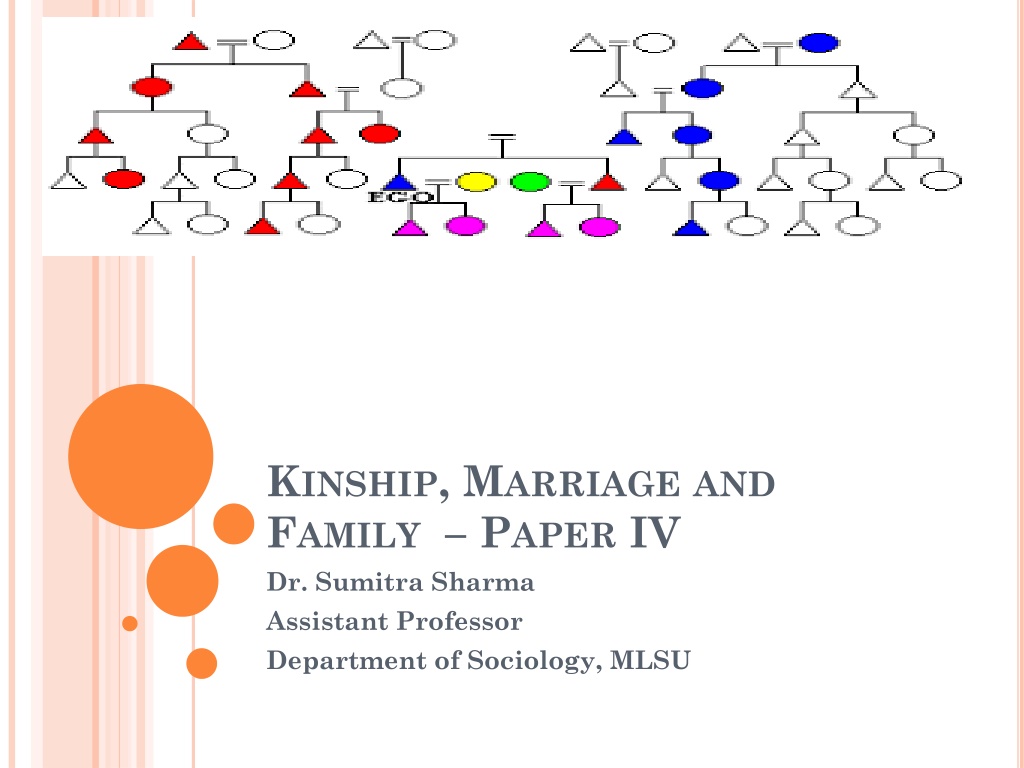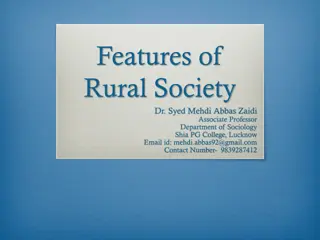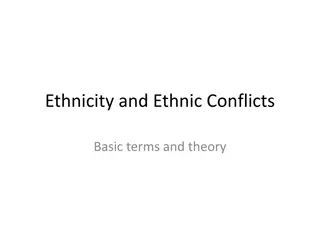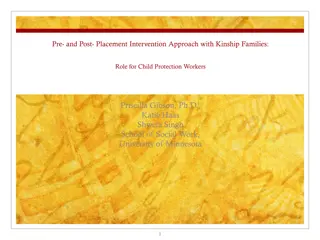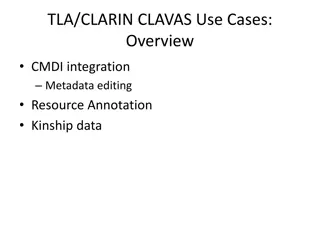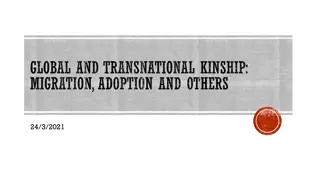Understanding Kinship, Marriage, and Family: Key Concepts and Readings
Explore the intricate web of social relationships that define kinship, marriage, and family structures in human societies. Delve into basic concepts such as consanguinity and affinity, kinship terminology, marriage rules, family composition, and changing patterns in India. Essential readings by renowned authors provide valuable insights into these sociological aspects.
Download Presentation

Please find below an Image/Link to download the presentation.
The content on the website is provided AS IS for your information and personal use only. It may not be sold, licensed, or shared on other websites without obtaining consent from the author. Download presentation by click this link. If you encounter any issues during the download, it is possible that the publisher has removed the file from their server.
E N D
Presentation Transcript
KINSHIP, MARRIAGE AND FAMILY PAPER IV Dr. Sumitra Sharma Assistant Professor Department of Sociology, MLSU
SYLLABUS Paper IV : Kinship, Marriage and Family (1694) Unit A Basic Concepts: Incest, Affiliation, Consanguinity, Affinity, Clan, Lineage, Kindered. Kinship and Descent: Unilineal, Double and Cognatic Descent & Complimentary Filiation Unit B Kinship Terminology. The Genealogical Method. Kinship Organization in India: Regional Variations Unit C Rules of Marriage: Endogamy, Exogamy, Prescriptive and Preferential Marriage, Monogamy, Polygamy, Levirate and Sororate , Hypo gamy and Hyper gamy. Unit - D Marriage Transaction: Dowry and Bride Price. Changing Patterns of Marriage among Hindu, Muslim and Christian. Unit E Family Structure and Composition. Changes in Family in India. Family and Gender Issues.
ESSENTIAL READINGS Fox, Robin (1967). Kinship and Marriage: An Anthropological Perspective. Harmondsworth Penguine Books. Kapadia, K.M.(1966). Marriage and Family in India ( in Hindi also ) Oxford University Press,London. Shah, A.M. (1998). The Family in India : Critical Essays, Orient Longman, New Delhi. Uberoi, Patricia (1993). Family , Kinship and Marriage in India, OUP, , New Delhi. Karve, Iravati (965). Kinship Organization in India. Asia Publishing House,Bombay. Shah, A.M. (1998). The Family in India . Critical Essays, New Delhi Orient Longman
- Male - Sibling -Female -Deceased person - Marriage -Divorce s - Descent
BASIC CONCEPTS: CONSANGUINITY & AFFINITY Human Being does not live alone death. Human being surrounded by a number of people like relatives, friends and neighbors, as well as by strangers and unknown people. He is bound to all those people who are related to him either on the basis of blood or marriage. Kinship is one of the important aspects of social structure and one of the basic principles for organizing individuals into social groups, categories and genealogy. Kinship system tide people to each others by the marriage and birth. Kinship is the social recognition of the biological ties of marriage and birth and all those who are related to each other through these bonds are known as kins . from birth to till
CONTINUE.. kinship is the web of social relationships that form an important part of the lives of all humans in all societies, Abercrombie et al. Kinship is the socially recognized relationships between people in a culture, who are either held to be biologically related or given the status of relatives by marriage, adoption, or other rituals.
TYPES OF KINSHIP: Two types Kinship : (i)Affinal Kinship, and (ii) Consanguineous Kinship. Affinal Kinship: - It refers to the relationships which formed on the basis of marriage. The most basic relationship that results from marriage is that between husband and wife. Those related to each other through marital relationship are called affinal kins. The kind of bond between spouses and their relatives on either side which arises out of legally defined marital relationship is known as affinal kinship. Ex.-Husband-Wife, Father- in law & Daughter-in-Law etc. .
CONTIN.. Consanguineous kinship: It refers to the relationships based on blood, i.e., the relationship between parents and children, and between siblings are the most basic and universal kinship relations. Those who are related to each other by blood are known as consanguineal cognates and the relationship based on blood-ties is called consanguineous (same blood) kinship. There are three types of consanguineal kins: Lineal kins who are the direct descendants of common progenitors in a vertical line, for instance, grand father-father-son-grand son. Siblings who are the brothers and sisters i.e., the children of the same parent. Collateral kins who are not related in the single line and are related indirectly through a linking relative, such as father s brother or brother s daughter. In connection to consanguineous kinship, not only biological fact (actual blood relationship) but also social recognition (adoption or convention as in polyandry) are important.
